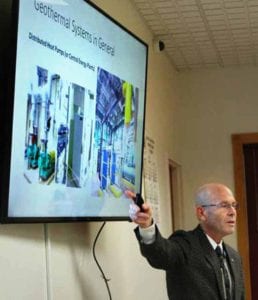2 Oneontas
Dip Toe Into
Geothermal
Consultant Explores Applying
Method To Main St., Southside
By JENNIFER HILL • Hometown Oneonta & The Freeman’s Journal

WEST ONEONTA – Geothermal energy fever is sweeping Greater Oneonta.
First the city and now the town are “seriously considering” going geothermal, using heat from beneath the earth to warm above-earth homes.
Jay Egg, a geothermal system consultant, met at length with City Manager George Korthauer and other staffers Tuesday, April 9, and is due back at City Hall this week with initial findings.
Wednesday, April 10, he briefed the Oneonta Town Board and the full audience in attendance.
Both municipalities are asking Egg for feasibility studies, the city for pairing geothermal development with replacing the South Main Street water main; the town, for doing the same on a loop that would be created for the Southside water district.
There are unknowns, said Town Supervisor Bob Wood. “We don’t know how much this would cost,” he said. “It will likely be at least a couple millions of dollars.”
Other unknowns are how much heat would be produced, how much it would cost, the return on investment, and home many businesses and homes need to connect.
Regardless, Egg said it’s a reality renewable energy will replace fossil fuels in the coming years, especially given New York State’s current incentives to switch.
“The basic of a geothermal system is a loop in the ground with something that will extract or reject the heat in the ground,” Egg said. That “something” can be anti-freeze or “a food-grade heating solution.”
A heat pump is then used to “move heat from one place and pump it into the building.” The heat pump “fits wherever a furnace fits,” Egg said. He emphasized the heat pump does not create heat.
Egg said a geothermal system for Southside would have “large ambient water loops, which maintain the ground temperature, which averages 55 degrees.” If the loops transmit water used for both heating the buildings and for drinking water, “a double-wall frame plate exchanger” would “direct only the non-potable, condenser water into the Southside buildings.”
Egg did not specify a price. Instead, he said Energy Service Companies (ESCOs) were ready and eager to invest in renewable energy, especially in New York State, which is aiming to have 50 percent of its energy be from renewable sources by 2030 and 80 percent by 2050.
Egg said an ESCO could “help the municipality become a utility that will offer different payment and ownership structures to the town.” He said the first step is to have a memo of understanding with an ESCO.
Wood said he did not know at this time whether the MOU town would advise or lead to a feasibility study like the one the city will have Egg do in the coming months. But he said he specifically asked Egg to talk about ESCOs at the board meeting.
Egg said if a geothermal system is installed in Southside, stores should connect to it sooner rather than later.
“If they do this now, they won’t have to drill a $15,000 hole or spend millions of dollars later because they have the infrastructure,” he said.
Egg listed geothermal’s benefits, including greater building comfort and performance, improved public health and safety, eliminating the need for boilers, furnaces and cooling towers, much lower heating costs, saving water, and reducing carbon emissions, which scientists cite as the primary driver of climate change.
“We have to get off combustion heating,” Egg said. “It’s a carrot now, but it’s going to become a stick because they’re going to tax the cost of fossil fuel out of reach of anyone.”

